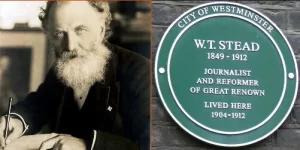 By KEN KORCZAK
By KEN KORCZAK
The true story of how Britain’s Greatest Journalist Died and Sent Back a Concisely Written News Story from ‘The Other Side.’
If you could send a person into the Afterlife to explore the environment of “The Other Side” and report back with a well-written, clear, concise and informative article, the best choice might be a seasoned investigative journalist.
Well, that’s exactly what happened in 1912.
That was the year when Britain’s greatest living journalist bought a ticket in England to sail to New York City.
The ship was the Titanic.
At the time, W.T. Stead was arguably the top newspaperman in Europe. In his 2020 book, University of Cambridge Professor Duncan Ball called W.T. “the most famous journalist in the British Empire.” W.T. Stead is credited with nothing less than inventing investigative journalism.
His long-form deeply researched stories brought profound changes to British government and society. He exposed corruption and reported on the unseemly underbelly of his nation. For example, W.T.’s expose on child prostitution scandalized British society and resulted in Parliament passing “The Stead Act” which raised the age of consent from 13 to 16. W.T. also revolutionized the look and presentation of newspapers. He was the first to deploy vibrant, attention-grabbing headlines followed by enticing sub-headlines and then easy-to-read inverted pyramid style copy.

So — yes — if I was an editor and wanted to assign someone to die, go into the Afterlife as a correspondent and send back a hard-hitting news piece on the Hereafter, my choice would be super journalist W.T. Stead. Fortunately for all of us, that’s what happened after W.T. drowned in the icy Atlantic on April 15, 1912.
MAKES CONTACT WITH DAUGHTER
Just days after receiving the shocking news of her father’s death, Estelle Stead consulted with medium, Etta Wriedt. At the beginning of the sitting, Estelle said she heard her father’s voice and saw a vision of his face.
This resulted in a 20-minute conversation with the deceased W.T. Stead and the publication of his first post-death report from The Other Side. The article ran in Pall Mall Magazine, a vehicle of the powerful Hearst news organization. Subsequently, Estelle consulted with several other high-profile London mediums, including the legendary Glady Osborne Leonard. In each case, W.T. came through strongly, and he had much to say about what he encountered in “the next world.”
The real work began, however, when Estelle Stead connected with a certain Mr. Woodman a few years later. Not a medium, psychic or clairvoyant, Mr. Woodman nevertheless became intensely curious about life after death after his brutal combat experience in World War I. Mr. Woodman was wounded and “invalided out” of the army. Then, when word came of the death of a dear friend on the front lines, he became keen to explore methods for contacting the dead.
In short, Mr. Woodman developed a facility with automatic writing, an arcane skill for which he seemed to have a superior natural aptitude. He began working with Estelle Stead who believed her father’s incessant drive to perform as a newsman had not diminished with the shedding of his physical form.
Meeting with Mr. Woodman, Estelle sat by him — she was like “the antenna” that drew her father’s energy — and Woodman placed a handkerchief over his eyes with one hand and let his other hand hold a pencil and roam free over a blank sheet of paper.
Estelle reports that Mr. Woodman could fill pages of copy in neat rows of sentences that did not crowd into each other. He could do so even in complete darkness. In this fashion, W.T. Stead — channeled through Mr. Woodman — was able to write his now famous book, “The Blue Island.” (Go to link to read for free). The third edition of the book was published in 1922. This is the source I am using for this article.
WHAT THE AFTERLIFE IS LIKE
Let me first say, as a former newspaper reporter, my sense in reading The Blue Island is that it is written by a person who was no stranger to a newsroom — a person who had a demanding pain-in-the-ass editor who insisted that all copy be lean, concise and free of unnecessary verbiage.
Reading The Blue Island is almost frustrating because W.T. Stead is so determined to report the essentials while sharpening the blade of his editing knife to trim the dross.
The Blue Island is a refreshing departure from the literary style of his day. W.T. dispenses with lengthy descriptive passages, does not digress to explore pithy points and just stays focused on the 5 Ws of a good news story — Who, What, When Where and Why.
With that in mind, let me, in turn, digest this even further and give you some of the key highlights and takeaways from The Blue Island. I don’t want to give it all away in case you want to download this free online selection eBook are read it for yourself. Again, you can find a copy to download or read online by clicking here: BLUE ISLAND
WHY BLUE?
What struck W.T. first was the pervasive “blueness” of the peaceful, earthlike environment in which he found himself upon arriving in “the next world.” It was not an overpowering blue, but merely a certain tint in the sunlight that was different from our yellow-white sunlight here on Earth.
W.T.’s companion-guide explains to him that the light source here simply tends a tad more to the blue within the light spectrum, and that accounts for the “healing” and “calming” cerulean atmosphere.
HIS COMPANIONS
Speaking of his companion-guide, this turned out to be a younger version of his own father who had died years earlier. (W.T. was 62 when he drowned). He clearly recognized his father and seemed his “same old self” except younger and in the prime of life.
A second companion joined W.T. and his father. This was a friend W.T. had known in physical form on Earth. These two companions accompanied W.T. on a tour of his new location in the Afterlife and answered all his questions.

EARTHLIKE BUT NICER
W.T.’s description of The Blue Island is similar to other Afterdeath accounts published at the time. For example, I found his description much like the “Summer Land” as described by Raymond Lodge, the son of famous British physicist Sir Oliver Lodge. Raymond Lodge was also killed in World War I. His brilliant father, like Estelle, used mediums to make contact with his son. Lodge published his book, “Raymond, or Life and Death” in 1917. (See my review here: RAYMOND).
Anyway, the Afterlife is like a beautifully landscaped park. There’s lots of greenery, gorgeous flowers, sparkling lakes and various buildings. The latter are of elegant — although not ostentatious — design. The weather is warm, sunny, calm and perfect.
WHAT DO THE “DEAD” DO?
W.T. reports that there is an activity for everyone in the Afterlife. At first, this tends to be a continuation of what interested a person most in physical life. Indeed, W.T. was amazed at how little things changed in terms of one’s physical body experience and general outlook after the death of the physical body.
W.T. said a dedicated athlete, for example, would find ways to express this athleticism — the pushing of the body to new limits of performance and achievement — to a much greater degree than they ever could have accomplished on Earth. Or let’s say a person was an avid reader, researcher and scholar. In W.T.’s Blue Island realm, fabulous libraries are available that house selections of books and manuscripts of incredible depth and far-reaching subject matter.
W.T. writes:
“Then there is the bookworm. He, too, finds intense satisfaction in his new-found facilities. Knowledge is unlimited — works of priceless value, lost upon earth, are in existence here.”
So, whether one is a musician or architect, actor or engineer, these activities can be pursued to the Nth degree and in a way that allows one to achieve unparalleled new heights.
However, W.T. said that, in all cases, those who delve into what they loved to pursue on Earth will sooner or later lose interest in that subject. They come to realize that there are much larger issues to grapple with and loftier concepts to explore in this higher dimension of reality. In effect, the activity of pursuing one’s former earthly interest is a transition aid enabling one to slowly let go of one’s former mode of existence before turning to another.
THE BLUE ISLAND IS TEMPORARY
W.T. tells us that the Blue Island is not Thee permanent Afterlife, though all are welcome to stay as long as they like, though the element of time is mute. That’s because the Blue Island is a timeless waystation. It is a place of respite and an abode of recovery from the vigorous challenges one has just endured by manifesting a physical life on Earth.
It’s a place to relax, recalibrate and think about what comes next.
W.T. speaks of “higher spheres” or reality that each individual soul must endeavor to attain by working out their personal issues with their own identity and by accessing the quality and characteristics of their consciousness. Raymond Lodge said much the same thing about his Summer Land. In fact, Lodge states that sometimes “Higher Beings” would descend into Summer Land to hold classes and provide instructions to the recently transitioned.
IS THE BLUE ISLAND FOCUS 27?
No doubt, skeptic reading this article will write off the Afterlife report of famous journalist W.T. Stead as an artifact of the typical beliefs of the era.
The late 19th through early 20th Centuries when seances proliferated and mediumship gained widespread traction among the British Victorian elite and a segment of the American intelligentsia — the latter perhaps exemplified by the brilliant William James, the “Father of American Psychology.”
Within this milieu — (the skeptics might continue) — story-form ideas gelled into a common language and belief system which fed on and enfolded upon itself. This created a kind of consensus mythology that was readily transmitted by automatic writers, such as Mr. Woodman, and was also recycled by the many mediums plying their trade in the day.
However, I can tell you that The Blue Island, AKA Summer Land (or whatever we name it), is a real place.
Anyone reading this need not take my word for it because anyone can prove to him or herself that the Blue Island is real by going there — and you don’t have to die or even have an NDE, a near-death experience. Today, the best name for it is Focus 27, a “name place” coined by the folks at The Monroe Institute, a leading consciousness research center in Faber, Virginia.
Here in this brief video, Dr. Franceen King and Dr. Joe Gallenberger, discuss the essentials of a program that assists participants in achieving the experience of going to the “Focus 27 Parkland,” which I suggest is the very same location as W.T.’s Blue Island and Raymond Lodge’s Summer Land.
Gallenberger, a Ph.D. psychologist with years of mainstream clinical practice, describes Focus 27 this way:
“You get into such high energy … there is a quick reset of the relaxation, expansion, free of time, the edge of space and time kind of focus level and then we go very quickly to Focus 27. That’s a vast area of awareness.
There is a small area — if you want to use the word “area” — that is nonphysical that we could call reception, and part of that is The Park. Bob Monroe (founder of the Monroe Institute) identified The Park as the place where many people went after a life in physical incarnation to be greeted by loved ones, to rest, rejuvenate and then move into what else they were going to do.
We call that part of the healing and regeneration — and so there are deep healing possibilities within that regeneration center. There are other beings called “coordinating intelligences” who operate behind this vast energetic field. So, Focus 27 is like a waystation with beings of all kinds of consciousness coming and going in the nonphysical.”
This sounds identical to that which is described by W.T. Stead and Raymond Lodge as it came out in the post-World War I era. Furthermore, hundreds of people who have taken the Monroe Institute’s Exploration 27 program report successfully accessing this realm via the use of binaural beat technology as administered in controlled isolation booths on site.
I would also note that many people today have reached the Focus 27 (or Blue Island) realm independent of using Monroe Institute techniques. One is Canadian psychologist Dr. Frederick Aardema. In his recent book, Adventures in Consciousness, (See my REVIEW) he reports finding himself in the Focus 27 Park.
While there, he entered a building that was much like the lobby of a hotel where guests checked in — and he has a fascinating experience there, but that’s a story for another time.
ME TOO
I also have been to The Blue Island, Summer Land, Focus 27, or whatever you prefer to call it, on many occasions in the course of my lucid dream and OBE practice of the past three-and-a-half decades.
That, too, is a story for another time.
However, I mention my own experience in visiting The Blue Island because I hope it will add weight to the notion that this 1922 book is an authentic document — and a bona fide report from “The Other Side” by one of the greatest journalists of all time.
NOTE: For more stories about the Afterlife, please see: KEN-ON-MEDIUM
